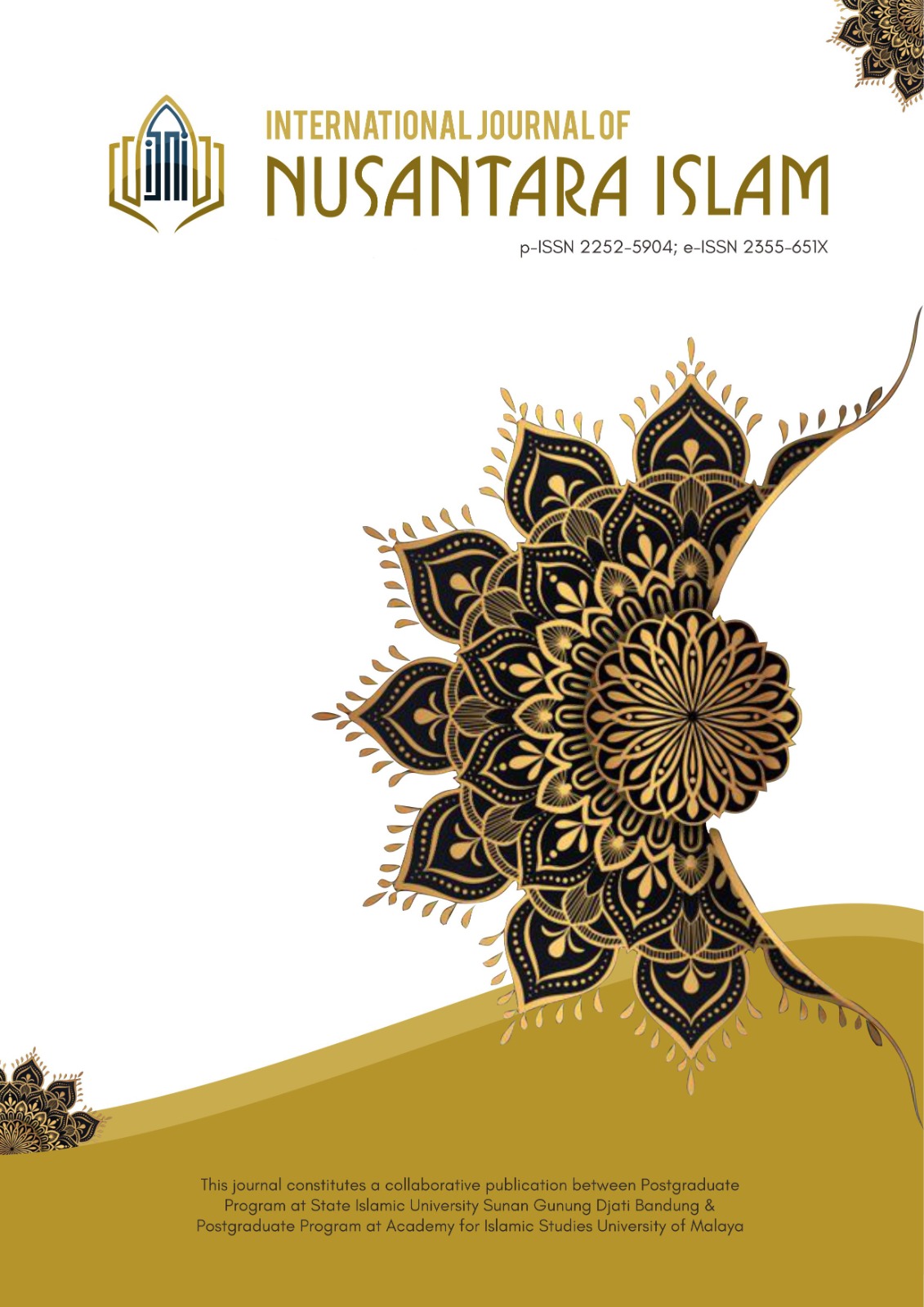Value of Tourist Attraction in Villa Kancil Kampoeng Soenda Bandung Regency
Main Article Content
Abstract
Article Details
The Authors submitting a manuscript do so on the understanding that if accepted for publication, copyright of the article shall be assigned to International Journal of Nusantara Islam, Sunan Gunung Djati State Islamic University.
The copyright encompasses exclusive rights to reproduce and disseminate articles in all forms and media, including reprints, photographs, microfilm, and similar reproductions, as well as translations. Some or all of the contents of this journal can be stored in databases and transmitted in any form and media without the need for written permission from the International Journal of Nusantara Islam, Sunan Gunung Djati State Islamic University.
The Editors and the Advisory International Editorial Board make every effort to ensure that no wrong or misleading data, opinions or statements be published in the journal. In any way, the contents of the articles and advertisements published in the International Journal of Nusantara Islam (IJNI) are sole and exclusive responsibility of their respective authors and advertisers.
References
Aprilia, E. R., Sunarti, S., & Pangestuti, E. (2017). Pengaruh Daya Tarik Wisata dan Fasilitas Layanan Terhadap Kepuasan Wisatawan di Pantai Balekambang Kabupaten Malang. Jurnal Administrasi Bisnis, 51(2), 16–21.
Assaker, G., & Hallak, R. (2013). Moderating Effects of Tourists’ Novelty-Seeking Tendencies on Destination Image, Visitor Satisfaction, and Short- and Long-Term Revisit Intentions: Journal of Travel Research, 52(5), 600–613. https://doi.org/10.1177/0047287513478497
Basiya, R., & Rozak, H. A. (2012). Kualitas Dayatarik Wisata, Kepuasan dan Niat Kunjungankembali Wisatawan Mancanegara di Jawa Tengah. Dinamika Kepariwisataan, 11(2), 1–12.
Chen, C.-F., & Tsai, D. (2007). How destination image and evaluative factors affect behavioral intentions? Tourism Management, 28(4), 1115–1122. https://doi.org/10.1016/j.tourman.2006.07.007
Databoks, 17 Juli 2019
Huang, S., & Hsu, C. H. C. (2009). Effects of Travel Motivation, Past Experience, Perceived Constraint, and Attitude on Revisit Intention: Journal of Travel Research, 48(1), 29–44. https://doi.org/10.1177/0047287508328793
Irawan, A. (2017). Analisis Pengaruh Daya Tarik Wisata, Persepsi Harga, dan Kualitas Pelayanan Terhadap Minat Berkunjung Ulang dengan Kepuasan Konsumen sebagai Variabel Intervening (Studi Kasus Objek Wisata Teluk Kiluan) [Undergraduate Thesis]. Universitas Lampung.
Muljadi, A. J. (2012). Kepariwisataan dan Perjalanan. Raja Grafindo Persada.
Pikiran Rakyat, 23 April 2019
Pitana, I. G., & Gayatri, P. G. (2005). Sosiologi Pariwisata: Kajian Sosiologis Terhadap Struktur, Sistem dan Dampak-Dampak Pariwisata. Andi.
Ramadlani, M. F., & Hadiwidjaja, D. (2012). Determinants of Tourist Revisit Intention to Kota Batu. Jurnal Ilmiah Mahasiswa FEB, 1(2), 1–20.
Som, A. P. M., Marzuki, A., Yousefi, M., & AbuKhalifeh, A. N. (2012). Factors Influencing Visitors’ Revisit Behavioral Intentions: A Case Study of Sabah, Malaysia. International Journal of Marketing Studies, 4(4), 39–50. https://doi.org/10.5539/ijms.v4n4p39
Sugiyono. (2008). Metode Penelitian Kuantitatif Kualitatif dan R&d. Alfabeta.
Suwantoro, G. (2004). Dasar-Dasar Pariwisata. Andi.
Syarifuddin, D. (2016). Nilai Wisata Budaya Seni Pertunjukan Saung Angklung Udjo Kota Bandung, Jawa Barat, Indonesia. Jurnal Manajemen Resort dan Leisure, 13(2), 53–60. https://doi.org/10.17509/jurel.v13i2.4979
Syarifuddin, D. (2017). Nilai Budaya Batik Tasik Parahiyangan sebagai Daya Tarik Wisata Jawa Barat. Jurnal Manajemen Resort dan Leisure, 14(2), 9–20. https://doi.org/10.17509/jurel.v14i2.8530
Syarifuddin, D. (2018). Nilai Citra Kota dari Sudut Pandang Wisatawan (Studi tentang Citra Kota Bandung Dampaknya terhadap Kunjungan Ulang). Journal of Indonesian Tourism, Hospitality and Recreation, 1(2), 1–10. https://doi.org/10.17509/jithor.v1i2.13761
Syarifudin, D., & Nurlatipah, L. (2015). Daya Tarik Wisata Upacara Tradisional Hajat Laut Sebagai Nilai Budaya Masyarakat Batu Karas. Jurnal Manajemen Resort Dan Leisure, 12(1), 100–110. https://doi.org/10.17509/jurel.v12i1.1050
Undang-Undang No.10 Tahun 2009 tentang Kepariwisataan
Warpani, S. P., & Warpani, I. P. (2007). Pariwisata dalam tata ruang wilayah. ITB.
Zaenuri, M. (2012). Perencanaan Strategis Kepariwisataan Daerah Konsep dan Aplikasi. e-gov publishing.
Zeithaml, V. A., Bitner, M. J., & Gremler, D. D. (2012). Services Marketing: Integrating Customer Focus Across the Firm. McGraw-Hill Irwin.

